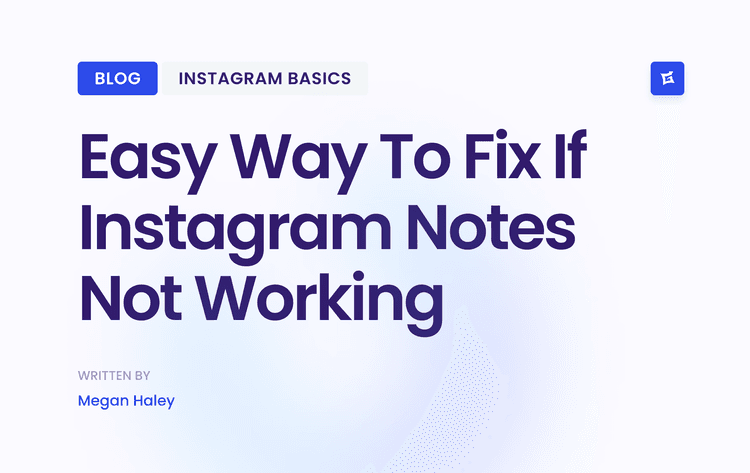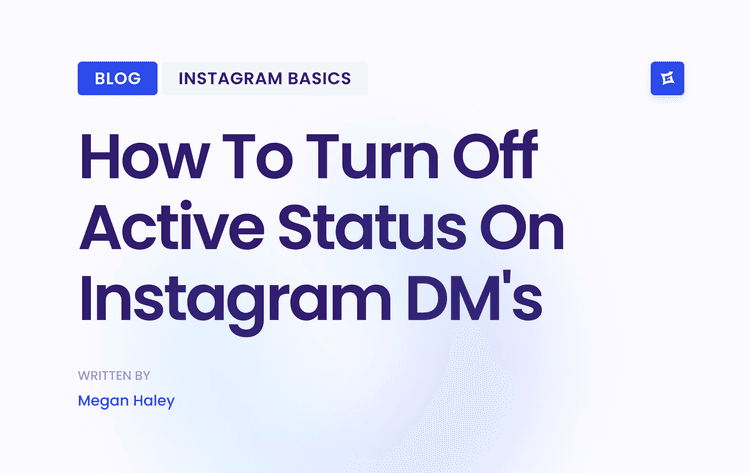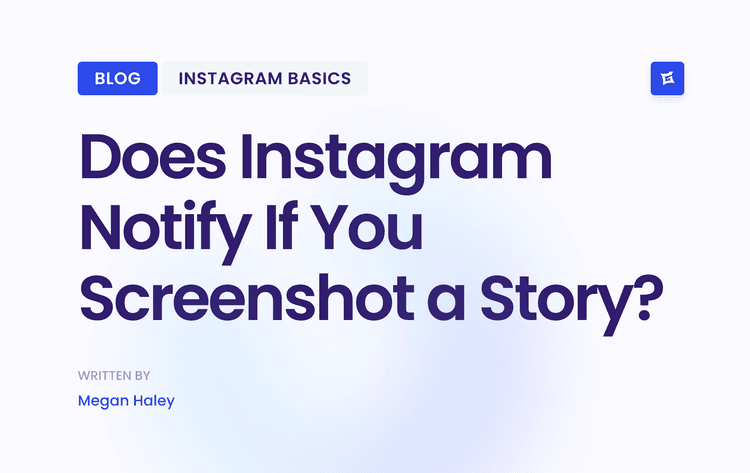Steal These 7 Content Strategies to Skyrocket Your Success
We'll analyze why these strategies worked, outlining specific tactics for you to replicate. These examples span diverse industries, offering a blueprint for success no matter your niche.
Ready to upgrade your content from average to amazing? We'll explore how these brands achieved remarkable results:
Red Bull: Extreme Sports Content
HubSpot: Educational Inbound Marketing
Airbnb: User-Generated Storytelling
Buffer: Transparent Company Culture
Nike: Inspirational Athlete Storytelling
American Express: Small Business Support
Patagonia: Environmental Activism
These content strategy examples provide a deep dive into the mechanics of successful campaigns. We'll uncover the core strategies, tactical execution, and measurable outcomes that propelled these brands forward. Once you have a solid strategy in place, a streamlined content creation workflow is essential for efficient production. (Source: Content Creation Workflow from WhisperTranscribe) Prepare to steal these winning formulas and apply them to your content strategy.
1. Red Bull's Extreme Sports Content Strategy
Red Bull's content strategy is a prime example of how a brand can transcend its product and become a media powerhouse. Instead of relying on traditional advertising, Red Bull built an empire by creating high-quality content centered around extreme sports, adventure, and lifestyle. This resonates deeply with their target audience, fostering a strong brand identity built on shared values of energy, excitement, and pushing limits. This approach has made Red Bull a leading example of a successful content strategy.
How It Works
Red Bull's strategy focuses on providing value to its audience by associating itself with captivating content rather than interrupting their experience with ads. They sponsor athletes, create documentaries, and host events like Red Bull Stratos (Felix Baumgartner's space jump) and Red Bull Rampage (mountain biking competition). This renew their marketing into entertainment, generating massive organic reach and brand affinity. If you're looking for ways to generate fresh content ideas, exploring different brainstorming methods can help unlock your creativity. (Source: Top Brainstorming Methods to Boost Creativity from Bulby)
This video showcases the breathtaking visuals and compelling storytelling that define Red Bull's content. The production quality is cinematic, rivaling major film studios, demonstrating their commitment to delivering premium experiences.
Actionable Takeaways
Align Content with Brand Values: Ensure your content reflects your core brand identity and resonates with your target audience's passions.
Invest in High-Quality Production: Stand out in a crowded digital landscape by creating content that looks and feels professional.
Create Tentpole Content: Develop flagship content pieces (events, documentaries, etc.) that generate significant buzz and long-term engagement.
Key Takeaways Visualized
The following infographic summarizes the key takeaways of Red Bull's content strategy.
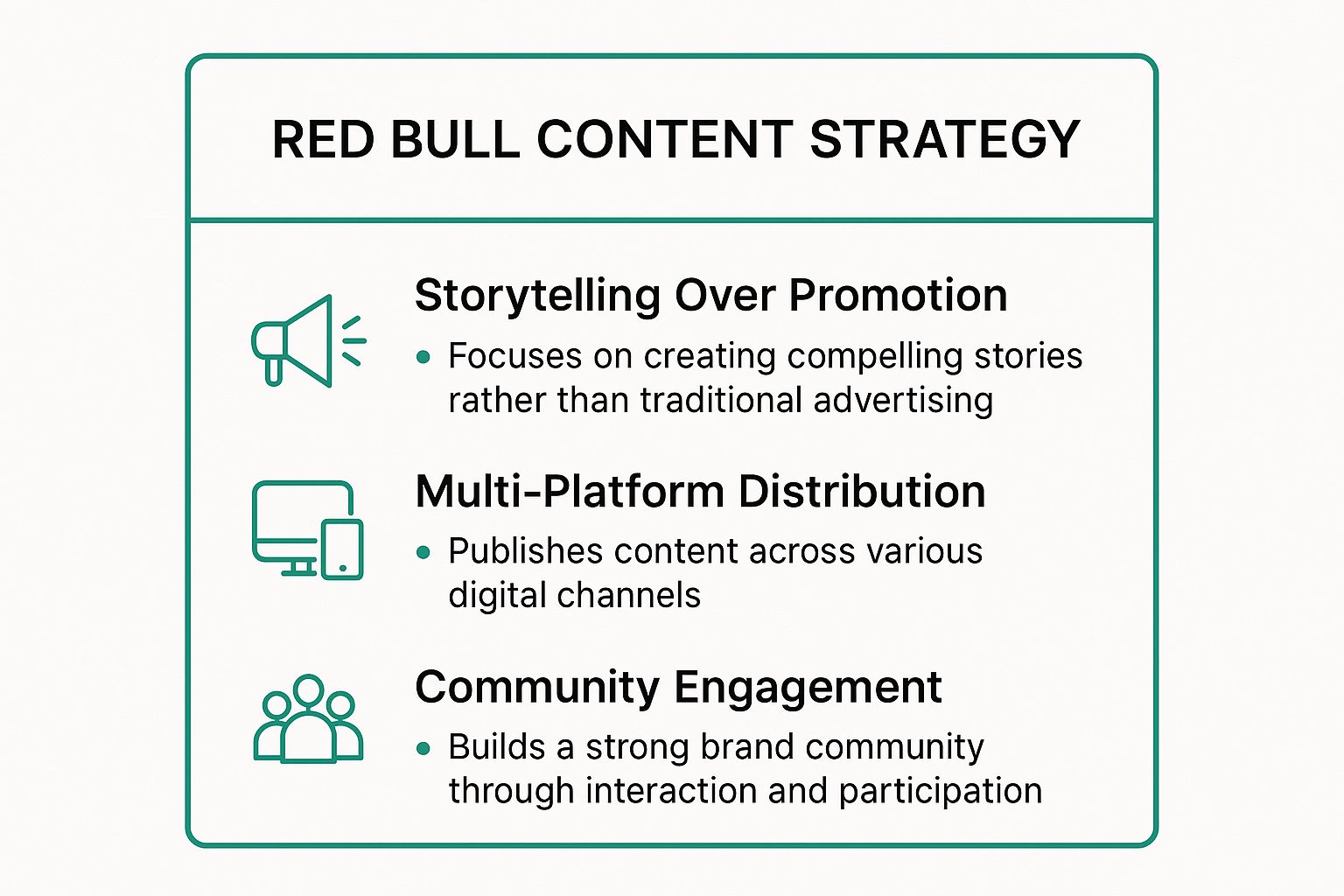
As the infographic highlights, Red Bull focuses on storytelling, multi-platform distribution, and fostering a passionate community. This combination has been instrumental in their success.
When and Why to Use This Approach
This content strategy is particularly effective for brands targeting audiences passionate about specific niches, especially those with a visual or experiential element. It requires a significant investment in content creation, but the potential rewards in terms of brand building and organic reach are substantial. Red Bull's commitment to quality and their understanding of their target audience allows them to build a loyal following and dominate their niche. This makes them a stand-out example among content strategy examples, demonstrating a strong link between content, community, and brand growth.
2. HubSpot's Educational Inbound Marketing Strategy
HubSpot's content strategy is a masterclass in inbound marketing. They've built their entire business model around providing free, valuable educational content related to marketing, sales, and customer service. This strategy establishes them as trusted experts, attracting and nurturing leads before they even consider purchasing HubSpot's software solutions. This positions them as a go-to resource and is one of the strongest content strategy examples.
How It Works
HubSpot's strategy focuses on attracting potential customers by providing valuable solutions to their problems. They offer a wealth of free resources, including their HubSpot Academy, which offers free certifications in marketing and sales. Their marketing blog publishes daily educational articles, and provides free tools like Website Grader and Email Signature Generator. This gives potential customers a taste of HubSpot's value offers, building trust and demonstrating expertise. If you aim to boost your social media account, consider exploring social media marketing tips. (Source: How to Create a Social Media Marketing Plan in 9 Steps from HubSpot)
Actionable Takeaways
Solve Real Problems: Focus your content on addressing your target audience challenges. Provide practical solutions and valuable insights that they can implement immediately.
Offer Free Value: Demonstrate the value of your product or service by offering free tools, resources, and educational materials. This builds trust and establishes your expertise.
Progressive Content Gating: Use content gating strategically to capture leads at different sales funnel stages. Offer premium content in exchange for contact information, nurturing leads towards conversion.
When and Why to Use This Approach
This content strategy is highly effective for businesses selling complex software or services. It's beneficial for companies with a long sales cycle, as it allows them to nurture leads over time. By educating potential customers and building trust, HubSpot positions itself as the preferred solution when the customer is ready to buy. This approach requires consistent content creation and a commitment to providing genuine value. The potential rewards, however, are significant in lead generation, brand building, and establishing market leadership, showcasing a strong connection between educational content and business growth. This is particularly effective for brands targeting audiences interested in academic content and practical solutions within a specific niche.
3. Airbnb's User-Generated Story Strategy
Airbnb's content strategy is a masterclass in leveraging user-generated content (UGC) and authentic storytelling. Instead of relying solely on polished advertising, Airbnb showcases real experiences from hosts and guests worldwide. This community-driven approach highlights unique travel experiences, local culture, and human connections, making travel feel personal and accessible. This resonates deeply with their target audience, fostering a strong brand identity built on shared experiences and a sense of belonging.

How It Works
Airbnb's strategy centers around providing value to its audience by building a platform for shared stories. They encourage hosts and guests to share their experiences through various channels, including social media, blog posts, and even dedicated publications like Airbnb Magazine. Campaigns like #OneLessStranger further amplified this community-driven approach, encouraging acts of kindness and connection among travelers. Learn more about Airbnb's User-Generated Story Strategy. This rebuilds their marketing from a broadcast to a conversation, generating authentic engagement and brand loyalty.
Actionable Takeaways
Empower Your Community: Create clear guidelines and incentives for user-generated content, making it easy for your audience to participate.
Curate and Amplify: Invest in content curation and quality control processes. Amplify the best user stories across multiple marketing channels to maximize reach and impact.
Visual Storytelling: Use high-quality visuals to showcase unique experiences and the personality of your brand, just like Airbnb uses captivating imagery of its unique properties.
Build Engagement: Foster community engagement through contests, featured stories, and interactive elements. Encourage dialogue and create a sense of belonging.
Key Takeaways Visualized
When and Why to Use This Approach
This content strategy is highly effective for brands in industries that thrive on personal experiences, such as travel, hospitality, and lifestyle. It requires a strong focus on community building and content curation. The potential rewards include increased brand authenticity, organic reach, and cost-effective marketing. Airbnb's success demonstrates the power of harnessing user-generated content to build a thriving brand community and drive business growth, making it a powerful example among content strategy examples.
4. Buffer's Transparent Company Culture Strategy
Buffer's content strategy stands out among content strategy examples because it leverages radical transparency as its core differentiator. Instead of hiding behind corporate veils, Buffer openly shares internal information, from revenue figures and employee salaries to company challenges and decision-making processes. This approach fosters trust, authenticity, and thought leadership, attracting customers who value openness and a strong company culture. This makes them a notable example within content strategy examples, showing the power of transparency.
How It Works
Buffer's transparency isn't just a marketing tactic; it's deeply ingrained in their company culture. They've developed tools like an open salary formula and a public salary database, alongside monthly dashboards showcasing revenue and user growth. Their "Buffer Open" blog provides insights into company experiments, even failures. They also publish transparency reports detailing their diversity and inclusion efforts. This consistent openness humanizes the brand and builds strong connections with its audience.
Actionable Takeaways
Start Small and Scale Up: Begin with manageable transparency initiatives and gradually increase openness as your team becomes comfortable.
Embrace Authenticity: Share both successes and failures to build genuine trust and credibility. Don't shy away from challenges; use them as learning opportunities.
Competitive Advantage: Use transparency as a unique selling proposition to differentiate your brand in a crowded market.
Team Alignment: Ensure all team members understand and support the transparency goals to ensure consistent messaging and buy-in.
Systematize Communication: Create systems and processes to maintaining consistent, transparent communication across different channels.
When and Why to Use This Approach
This content strategy is particularly effective for companies seeking to build a strong brand community based on shared values. It's especially relevant for B2B companies and those in industries where trust and authenticity are paramount. While radical transparency may not be suitable for every organization, incorporating elements of openness can significantly enhance brand perception and customer loyalty. Airbnb's content strategy heavily relies on showcasing user-generated content. For more insights, explore this guide on user-generated content. (Source: User Generated Content: The Ultimate Brand Success Guide from Publora) This approach can also give your brand a competitive edge, similarly to Buffer’s transparent culture content strategy.
This approach resonates with audiences seeking authentic connections. By being open and honest, brands can build stronger relationships with their customers and establish themselves as thought leaders. Buffer is a leading example amongst content strategy examples by showcasing how transparency can enhance brand trust and engagement.
5. Nike's Inspirational Athlete Storytelling Strategy
Nike's content strategy centers on inspirational storytelling featuring athletes overcoming challenges, pursuing dreams, and achieving greatness. Their "Just Do It" philosophy is woven throughout content that motivates and empowers audiences to push their limits. This strategy effectively connects athletic performance with personal growth and determination, resonating deeply with a broad audience.

How It Works
Nike's strategy focuses on creating emotional connections with its audience by showcasing relatable human stories of perseverance. They partner with athletes who embody their brand values, amplifying their narratives through high-quality videos, social media campaigns, and documentaries. Examples include Colin Kaepernick's "Dream Crazy" campaign, Serena Williams' empowerment campaigns, and the Michael Jordan "The Last Dance" documentary partnership. These powerful narratives transcend sports, inspiring audiences in all aspects of their lives. Learn more about Nike's Inspirational Athlete Storytelling Strategy through effective visual storytelling techniques.
Actionable Takeaways
Focus on Universal Themes: Tap into emotions like perseverance, determination, and overcoming adversity, as these resonate with a wide audience.
Partner with Authentic Voices: Collaborate with athletes and influencers who genuinely embody your brand values and inspire others.
Invest in High-Quality Storytelling: Compelling narratives and strong production values are crucial for capturing and holding audience attention.
When and Why to Use This Approach
This content strategy is effective for brands aiming to build a strong emotional connection with their audience. It's particularly relevant for businesses in the fitness, sports, and lifestyle industries, but the core principles of inspirational storytelling can be adapted across various niches. This approach requires a commitment to authenticity and a deep understanding of your target audience's values and aspirations. Nike's success provides a compelling case study among content strategy examples, demonstrating how powerful storytelling can elevate a brand beyond its products and cultivate a loyal, engaged community.
6. American Express's Small Business Support Strategy
American Express's content strategy provides a powerful example of how a brand can cultivate deep customer loyalty by addressing the specific needs and challenges of its target audience. Instead of focusing solely on promoting its financial products, American Express built a robust platform of resources and community support specifically for small business owners. This strategy effectively positions them as a valuable partner invested in their customers' success, ultimately driving brand affinity and long-term engagement. This approach has earned American Express a place among exemplary content strategy examples.
How It Works
American Express created OPEN Forum, an online community and content platform offering expert advice, networking opportunities, and resources tailored to small business needs. They also launched Small Business Saturday, an annual campaign encouraging consumers to support local businesses, demonstrating their commitment to the small business community. In addition, they offer Business Class, a blog filled with actionable insights and educational webinars. These initiatives provide genuine value to small businesses, fostering strong relationships and establishing American Express as a trusted advisor. Learn more about the various aspects of their strategy about social media, and how they apply to American Express, on our blog about powerful small business social media tips.
Actionable Takeaways
Focus on Problem-Solving: Create content that directly addresses the challenges faced by your target audience.
Build Community: Facilitate peer-to-peer learning and networking opportunities to foster a sense of belonging.
Partner with Experts: Collaborate with industry leaders and successful entrepreneurs to provide credible and valuable insights.
Provide Actionable Advice: Offer practical tools and resources that empower your audience to implement your recommendations.
When and Why to Use This Approach
This content strategy is particularly effective for brands targeting specific professional or interest-based communities. It’s especially valuable in B2B contexts, where building trust and demonstrating expertise are crucial for converting leads and retaining customers. While the initial investment in building a community and creating valuable resources can be significant, the long-term rewards in customer loyalty, brand advocacy, and organic growth can be substantial. American Express’s approach highlights how focusing on genuine support and community building can be a powerful differentiator in content strategy examples, effectively connecting content, community, and business growth.
7. Patagonia's Environmental Activism Strategy
Patagonia's content strategy is a powerful example of how a brand can integrate its core values into its marketing, conversing environmental activism into a driver of customer loyalty and brand differentiation. Instead of simply selling outdoor apparel, Patagonia actively champions environmental protection, sustainable business practices, and social causes. This approach resonates deeply with their target audience, fostering a community united by shared values. This makes Patagonia a compelling example among content strategy examples.
How It Works
Patagonia's strategy centers on authentic advocacy. They don't just talk about environmentalism; they actively participate in it. Their "Don't Buy This Jacket" campaign, for instance, challenged consumerism head-on, encouraging repair and reuse over new purchases. Their founding of 1% for the Planet, committing 1% of sales to environmental organizations, demonstrates their dedication. Producing films like "The Cove" and "DamNation" further highlights their commitment to environmental issues. (Source: Patagonia's website: www.patagonia.com)
Patagonia's content actively engages their audience in environmental discussions. They provide resources, highlight environmental issues, and encourage participation in activism campaigns. This approach builds their marketing into a platform for change, fostering genuine connections with their audience.
Actionable Takeaways
Align Activism with Brand Values: Ensure your advocacy aligns authentically with your core brand identity and actions.
Back Up Advocacy with Action: Demonstrate your commitment through tangible actions and business practices.
Educate and Inform: Create content that educates and empowers your audience to take action.
Engage Your Community: Foster meaningful engagement with your community to support shared causes.
When and Why to Use This Approach
This content strategy is particularly effective for brands targeting audiences passionate about social or environmental issues. It requires genuine commitment and transparency, as inauthenticity can be easily detected. However, when executed authentically, as Patagonia demonstrates, purpose-driven marketing can build strong customer loyalty, brand differentiation, and positive social impact. Patagonia demonstrates a strong link between activism, community, and brand growth, making it a unique example among content strategy examples.
Content Strategy Comparison: 7 Leading Examples
Red Bull’s Extreme Sports Content
This strategy has high implementation complexity, requiring multi-channel, high-quality production. It also demands a large budget for production and event sponsorship. The expected outcomes include strong brand association, a passionate community, and organic reach. It is ideal for brands aiming for lifestyle branding and high engagement. The key advantages are strong brand identity, entertainment value, and thought leadership.HubSpot’s Educational Inbound
Implementation is medium to high in complexity, needing consistent content creation and SEO optimization. The resource requirements are moderate, involving a content team, SEO, and tool development. The outcomes include authority building, high-quality lead generation, and long-term trust. This strategy suits SaaS and B2B companies focused on lead generation. It helps establish trust, offers measurable ROI, and supports organic traffic growth.Airbnb’s User-Generated Story
With medium complexity, this approach involves community management and content curation. It requires low to moderate resources, mostly from user-generated content with some curation. The results are authentic brand trust, emotional connection, and social proof. It's best for platforms that depend on community and shared experiences. Its key advantages are cost-effectiveness, authenticity, and strong community engagement.Buffer’s Transparent Culture
This medium-complexity strategy relies on consistent transparency and content sharing. It requires moderate resources, such as internal systems and content creation. The outcomes include exceptional trust, brand loyalty, and media coverage. It is suitable for companies that prioritize trust and radical transparency. Its strengths are loyalty-building, brand differentiation, and talent attraction.Nike’s Inspirational Storytelling
Highly complex, this strategy involves high production values and athlete partnerships. It also demands a high budget for production and talent. The anticipated outcomes are emotional connections, social engagement, and a premium brand image. It's ideal for brands looking to foster emotional brand connections and empowerment. The key advantages are emotional appeal and strong social shareability.American Express’s Small Business Content
This strategy has medium complexity, involving educational and community content and expert partnerships. The resource needs are moderate, including content, events, and collaborations. The results include credibility, customer relationships, and business community support. It fits financial services and business support platforms well. It builds trust, enhances thought leadership, and aids in acquisition and retention.Patagonia’s Environmental Activism
Implementation is medium to high in complexity, focusing on cause alignment, activism, and documentary content. The strategy requires moderate resources for content production and activism initiatives. Expected outcomes include deep emotional connection, brand differentiation, and media attention. It is best for brands committed to social responsibility and activism. Its advantages lie in a strong purpose-driven identity and appeal to values-aligned customers.
Level Up Your Content Strategy Today
This collection of content strategy examples showcases the power of a well-defined approach. From Red Bull's adrenaline-pumping content to Patagonia's environmental advocacy, each brand demonstrates the importance of aligning content with core values and target audience interests. These diverse examples offer valuable insights for anyone looking to enhance their content strategy, particularly on platforms like Instagram.
Key Takeaways for Effective Content Strategies
Let's recap some of the most impactful takeaways:
Audience Understanding is Key: Knowing your audience's needs, preferences, and online behavior is paramount. Whether it's extreme sports enthusiasts or environmentally conscious consumers, tailoring your content to resonate with your target demographic is essential.
Authenticity Drives Engagement: Brands like Buffer and Patagonia demonstrate the power of authenticity. By staying true to their core values and transparently communicating their message, they build trust and foster deeper connections with their audience.
Value-Driven Content Wins: Providing valuable content, whether it's educational resources like HubSpot or inspiring stories like Nike, establishes your brand as a thought leader and attracts a loyal following.
Strategic Storytelling is Powerful: Compelling narratives, like those employed by Airbnb and Nike, captivate audiences and create memorable brand experiences. Stories resonate on a deeper emotional level, fostering stronger connections.
Putting These Insights Into Action
These content strategy examples aren't just inspiring stories; they're blueprints for success. You can adapt these strategies to your brand and niche. Here are some actionable steps:
Define Your Target Audience: Identify your ideal customer. What are their interests, needs, and online behavior?
Develop a Content Calendar: Plan and schedule your content in advance to maintain consistency and ensure a diverse mix of content formats.
Analyze and Optimize: Regularly review your content performance and make adjustments based on data and audience feedback. Continuous optimization is key to long-term success.
The Power of a Strong Content Strategy
Mastering these concepts is crucial for building a strong online presence and achieving your business goals. A well-defined content strategy allows you to connect with your target audience, build brand awareness, drive engagement, and ultimately achieve measurable results. Whether you're a small business, a growing brand, or an individual influencer, a strategic approach to content creation is essential for success in today's digital landscape.
A strong content strategy forms the bedrock of any successful online presence. By learning from these content strategy examples and implementing the key takeaways, you can create content that resonates, engages, and drives results. Want to amplify your message and accelerate your organic Instagram growth? Gainsty provides the tools and insights to implement these strategies effectively and reach a wider audience. Check out Gainsty today and discover how to take your content strategy to the next level.


.png&w=1920&q=75&dpl=dpl_9XSWKBjhcBN6v6b1SN7m3p1WWjfr)
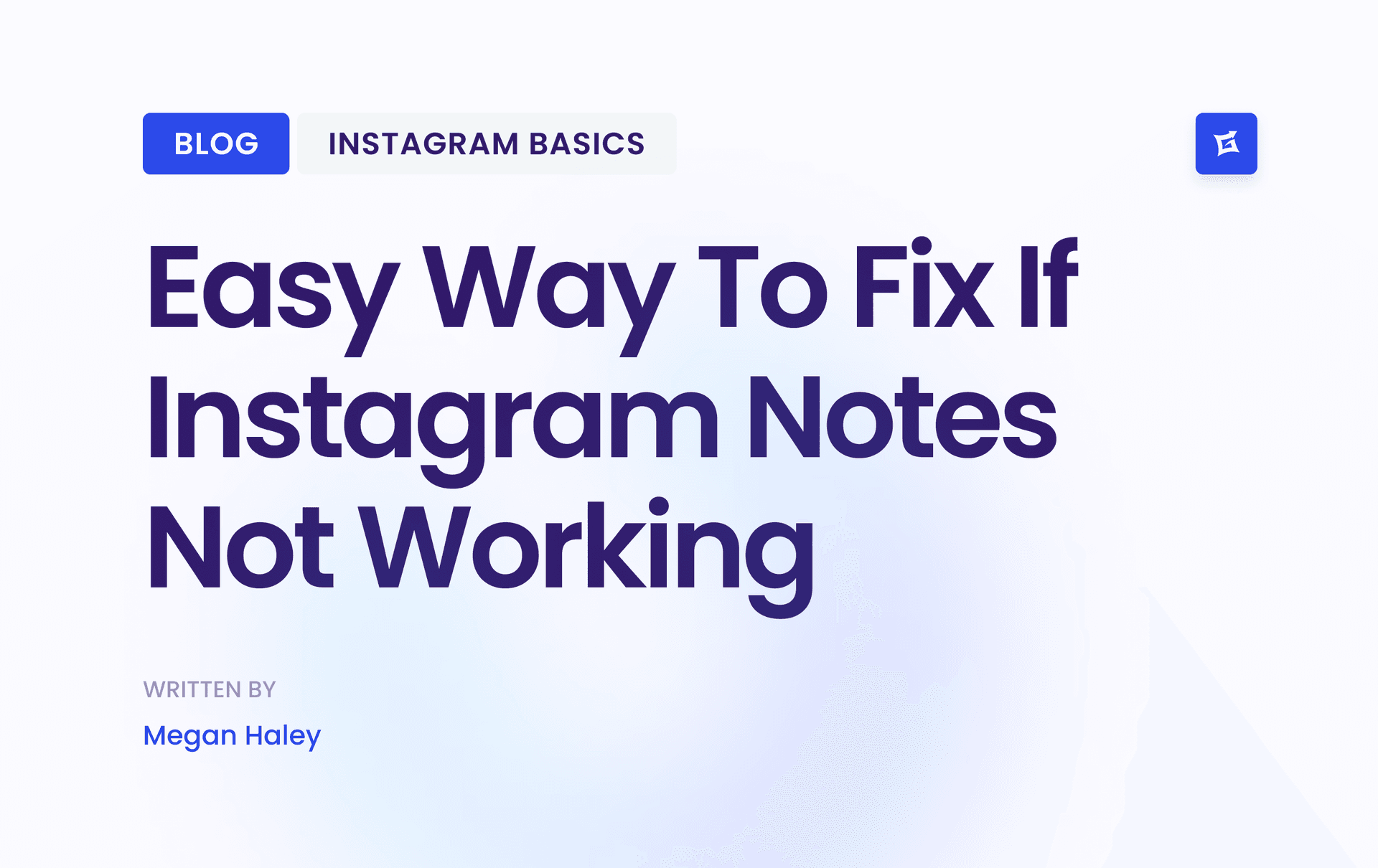

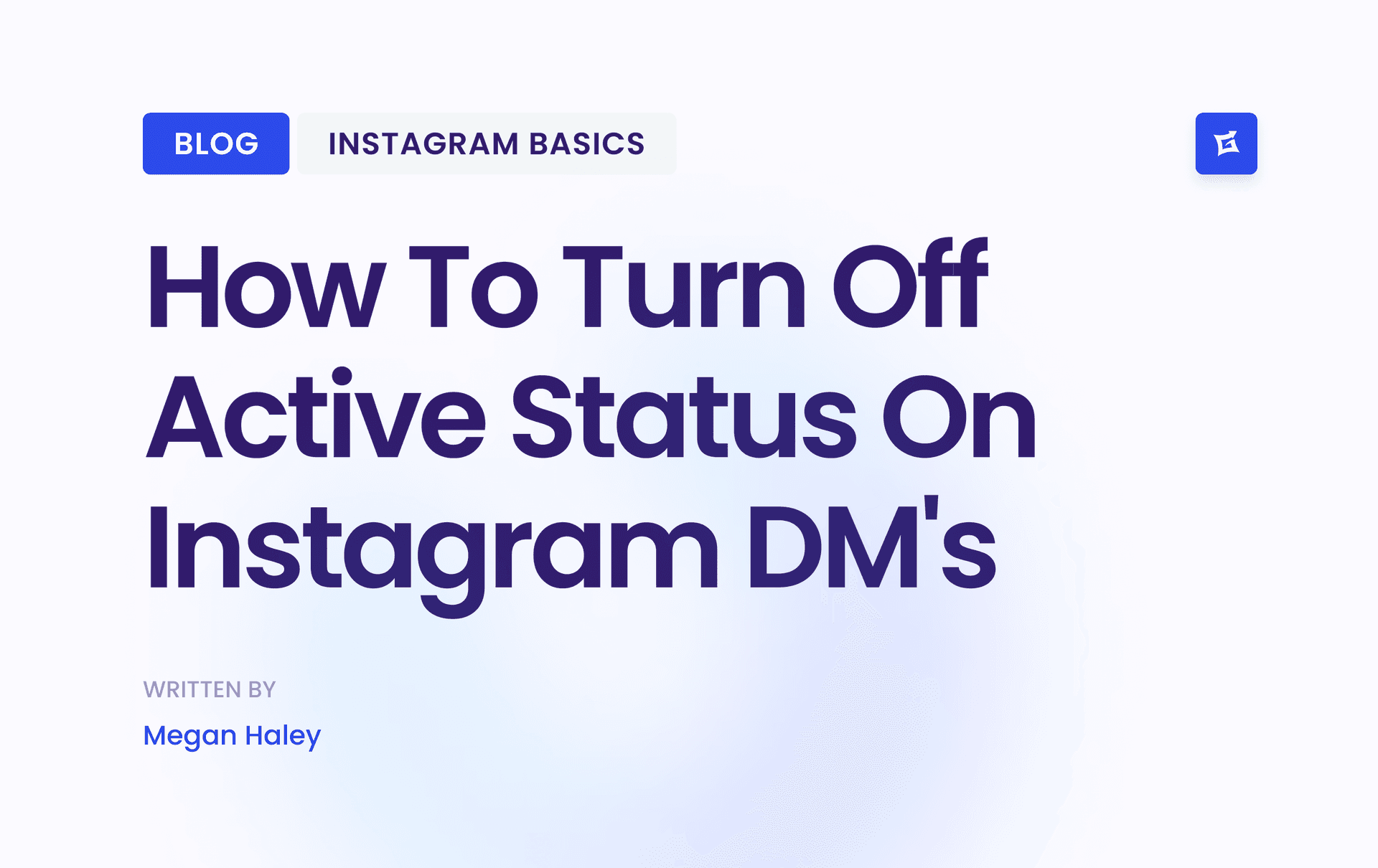





.png&w=750&q=75&dpl=dpl_9XSWKBjhcBN6v6b1SN7m3p1WWjfr)
